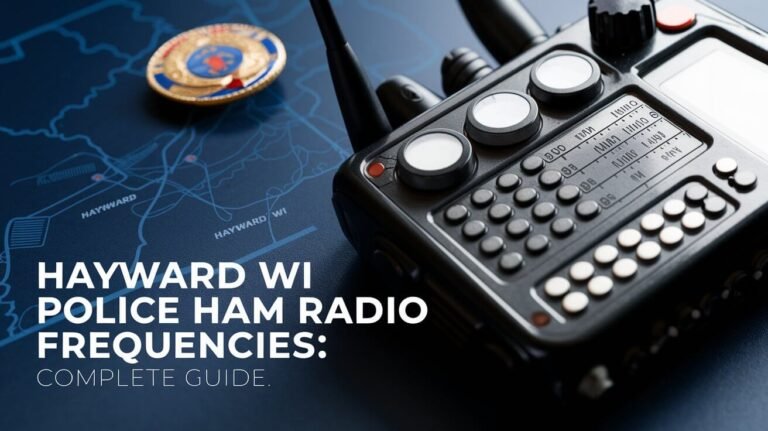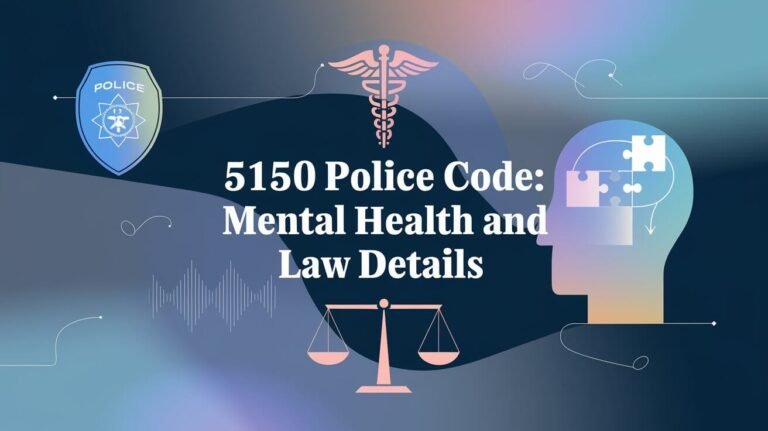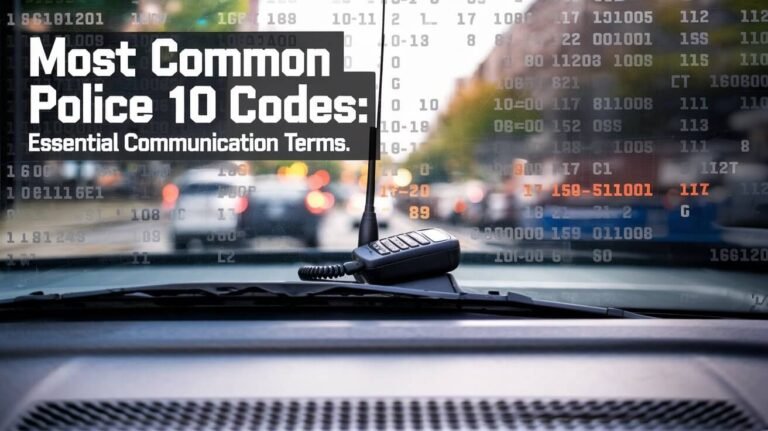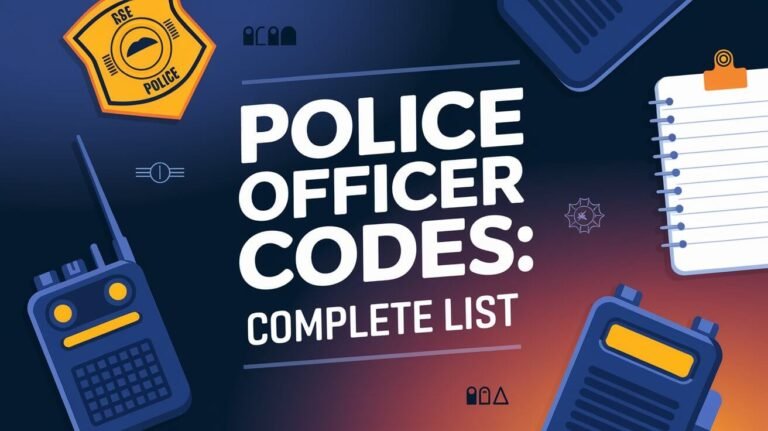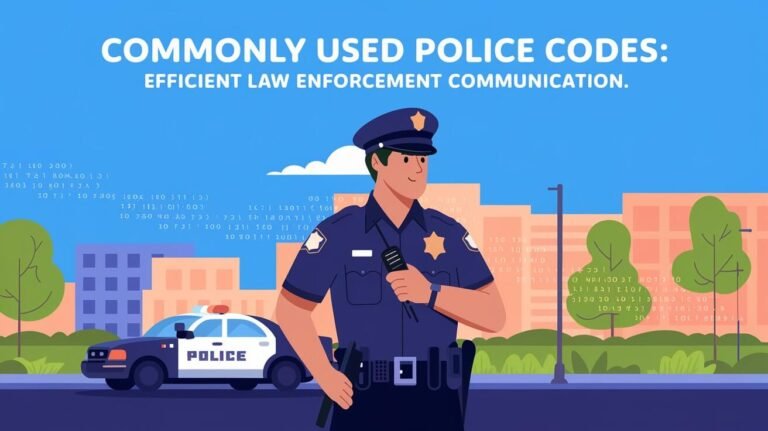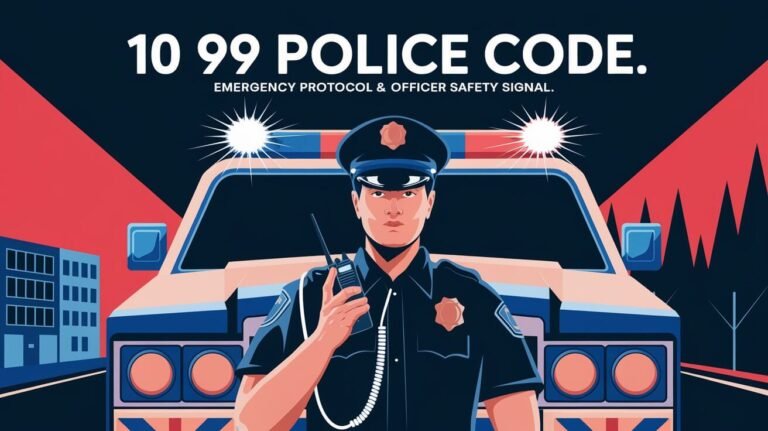Police Code For Dead Body: Commonly Used Signals Explained
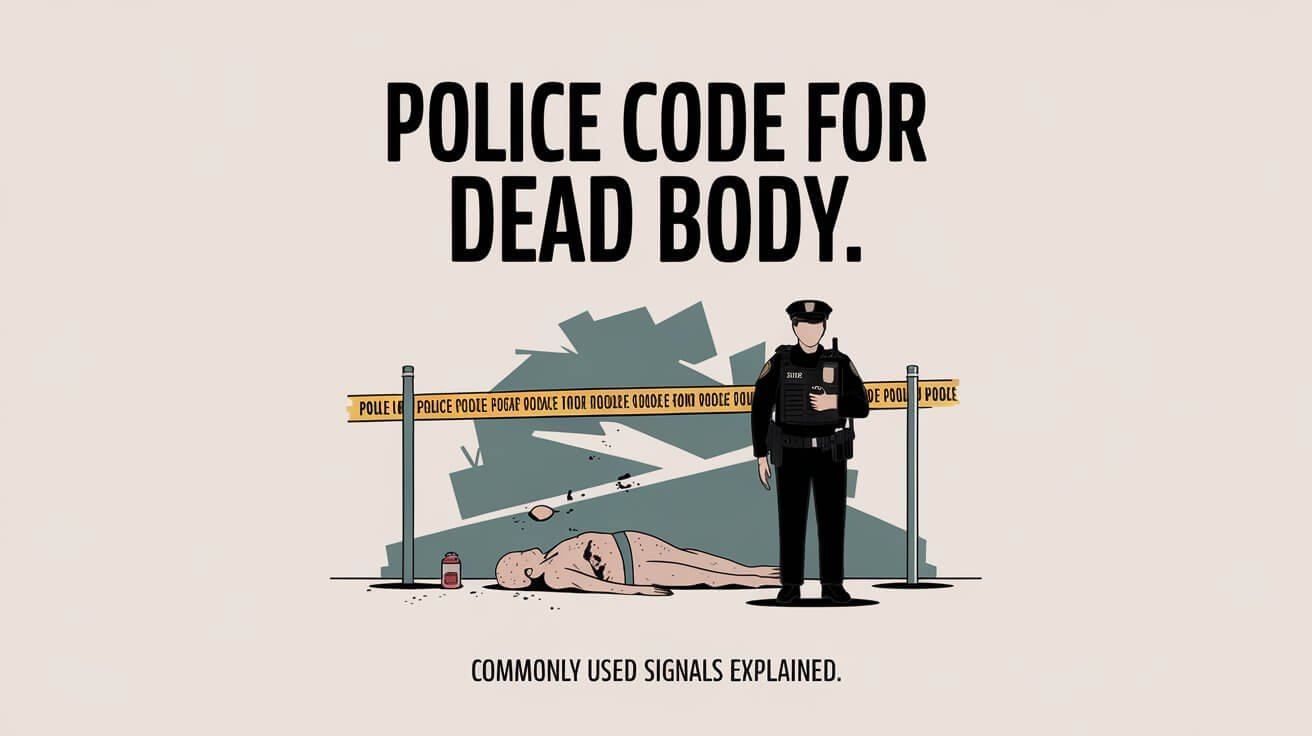
Clear and efficient communication is essential in law enforcement. When dealing with a deceased person, police use specific radio codes. These codes, like “10-45D” (Patient Deceased), help them quickly start the death investigation.
Using these codes, officers can alert their team about fatalities without causing a stir. This ensures the right people are there to handle the situation with care and respect. It shows law enforcement’s dedication to treating the deceased and their families with dignity.
Police Radio Codes for Death Notifications
Police radio codes are essential in law enforcement. They help officers share important death-related info quickly and quietly. This ensures a professional and caring response.
Code 10-45D: Patient Deceased
When officers find a dead person, they use “10-45D” to tell dispatch. This code starts special steps, like calling the coroner or medical examiner to the scene.
Code 10-54: Possible Dead Body
“10-54” is used when officers think someone might be dead but need to check. It leads to a detailed check before confirming the death.
Code 10-55: Coroner’s Case
Deaths that seem suspicious or unattended are called “10-55” or “Coroner’s Case.” This code tells the coroner or medical examiner to come. They figure out how and why the person died.
These codes are vital for clear communication after a death. They help officers work together well. This keeps the investigation strong and supports everyone involved.
| Code | Description |
|---|---|
| 10-67 | Report of Death |
| 10-50 | Accident PD,PI,F |
| 10-54 | Hit & Run PD,PI,F |
| 10-91 | Rape/Sexual Offense |
| 10-44 | Riot |
| 10-93 | Open Garage Door |
| 10-99 | Out of Radio Contact |
| 10-43 | Chase |
“Police radio code 10-66 denotes a notification to ‘Notify Medical Examiner,’ while code 10-67 indicates a report of a death.”
These codes are used in Winston-Salem, North Carolina. They help officers talk about different incidents, including deaths, in a standard way.
Death Investigation Scene Procedures
Conducting a thorough death investigation at the crime scene is key to understanding a body recovery. Police officers must follow set protocols. This helps preserve evidence and keeps the investigation’s integrity intact.
The first step is to secure the area and limit access. Officers then take many photos of the scene. They document the body’s position and any evidence.
They collect physical evidence like weapons, clothes, or personal items. This evidence is cataloged to keep track of who handled it.
- Establish a perimeter and restrict access to the area
- Photograph the scene extensively, capturing the body’s position and any evidence
- Collect and catalog physical evidence, preserving the chain of custody
Interviews with witnesses can give important insights into what happened before the death. Officers also have to notify the next of kin. This is a sensitive task that requires care and understanding.
“The death investigation scene is a delicate and critical stage of the process. Officers must balance the need to gather evidence with the respect and dignity owed to the deceased and their loved ones.”
In unclear or suspicious cases, the medical examiner is called in. They may do an autopsy to find out how and why the person died. They also collect more evidence for analysis.
Sticking to protocols and working with medical experts, law enforcement can conduct death investigations carefully. This helps bring closure and justice to those affected by loss.
Police Code For Dead Body Reference Guide
When police officers find a dead body, they must follow strict rules. These rules help them document the scene, keep evidence safe, and work with other authorities. This guide explains the steps officers take at a death scene.
Initial Response Protocols
Officers first make sure the area is safe and call the right people. They do this by:
- Setting up a barrier to keep the scene clean
- Keeping witnesses away
- Calling for more help and the coroner
- Helping if the person might be alive
Documentation Requirements
It’s very important to document a death scene well. Officers need to:
- Write a detailed report of what they see
- Take photos from different angles
- Keep a log of who has the evidence
Chain of Custody Procedures
Officers must handle evidence carefully to keep it safe. They do this by:
| Step | Procedure |
|---|---|
| Collection | Collect, package, and label evidence correctly |
| Transportation | Put evidence in a safe container and take it straight to the right place |
| Storage | Keep evidence in a safe place until it’s needed for analysis or court |
Following these steps helps officers do a good job, no matter the cause of death.
Crime Scene Management and Body Recovery
Managing a crime scene is key for law enforcement. It helps keep evidence safe and treats human remains with respect. A guide on crime scene investigation was created by a group of experts. It was approved in January 2000 by the National Institute of Justice.
Police officers face different crime scenes. They must first check if the area is safe. This includes looking for the suspect, weapons, and dangerous conditions.
When a body is found, the process is very detailed. The body is photographed where it was found. Then, it’s documented and moved to the morgue for more checks. This is done with great care to respect the deceased and keep the investigation accurate.
In today’s world, controlling what the public knows is hard. News spreads fast online, which can harm the investigation. Police are careful about what they share to keep the case fair.
The crime scene guide was made by a team of experts. It helps police follow best practices. This way, they can handle crime scenes well, treat bodies with respect, and keep the investigation strong.
Communication Guidelines During Body Discovery
Clear communication is crucial when police officers find a dead body. They must follow strict rules to keep the investigation honest and show respect for the person who died.
Radio Etiquette
Officers use special codes on the radio when they first arrive at a death scene. Codes like “10-45D: Patient Deceased” or “10-54: Possible Dead Body” are used. It’s important to speak clearly and briefly to avoid mistakes and make sure everyone knows what to do.
Dispatcher Interaction Protocol
Good communication between officers and dispatchers is vital. Dispatchers need to know the exact location, what happened, and what’s needed right away. This helps them send the right help, like calling the coroner or more detectives.
Information Security Measures
When dealing with a death investigation, officers must be very careful. They should keep all information about the case and the person who died private. This means not sharing too much and keeping the case confidential.
Following these rules helps police officers handle death scenes well. They can work together smoothly, keep the investigation honest, and show respect for the person who died.
Coroner and Medical Examiner Coordination
Working with coroners and medical examiners is key in death investigations. When someone dies, police must quickly tell the right people. This starts the process of figuring out how and why the person died.
It’s important for police to know what coroners and medical examiners do. Deaths need to be reported fast, usually within an hour. This helps the Medical Examiner-Coroner’s Office do their job right.
- Bodies can only be moved with permission, to keep important evidence safe.
- For bodies found in water, they should be moved to a safe spot before the Coroner arrives. But, bodies underwater should only be taken out with the Coroner there.
- If a body is in danger, like from fire, it can be moved to safety before the Coroner is told.
- Before a body is taken to the Coroner’s Forensic Science Center in Los Angeles, the Coroner must say it’s okay.
| Occupation Code | Occupation Title | Relevance to Coroner and Medical Examiner Coordination |
|---|---|---|
| 13-1041.06 | Coroners | Belong to the Business and Financial Operations Occupations category |
| 19-4092.00 | Forensic Science Technicians | Related to the activities of Coroner and Medical Examiner Coordination |
| 33-3021.00 | Detectives and Criminal Investigators | Associated with the investigation of deaths by Coroners |
| 29-2072.00 | Medical Records Specialists | Mentioned in the context of Coroner and Medical Examiner coordination |
Teaming up with coroners and medical examiners, police can do a complete and correct death investigation. This leads to a detailed report and the right steps at the morgue.
Evidence Collection at Death Scenes
When collecting evidence at death scenes, every detail matters. It’s important to document and handle evidence well. This is key for solving cases and preparing for court.
Photography Requirements
It’s vital to take detailed photos of the crime scene and evidence. Investigators need to capture the whole scene and close-ups of evidence. This helps create a clear visual record.
Physical Evidence Handling
Collecting, packaging, and labeling evidence needs to be done carefully. Investigators must keep the evidence chain of custody intact. This prevents contamination and ensures evidence is ready for analysis.
Documentation Standards
Keeping detailed records of all observations and evidence is essential. Investigators must document everything accurately. This helps build strong case files that can stand up to court scrutiny.
| Statistic | Value |
|---|---|
| According to the Code of Criminal Procedure, a justice of the peace shall conduct an inquest into the death of a person who dies in the county served by the justice under specific circumstances | Unnatural death, unidentified body with unknown cause of death, death with possible unlawful causes, suicides, unattended deaths, deaths attended by physicians unable to certify cause of death, or deaths of children under the age of six |
| Physicians attending a death and unable to certify the cause of death are required to report to the justice of the peace for an inquest | – |
| A justice of the peace must report deaths with unidentified bodies to specific databases within a specified timeframe | – |
| The Code allows for the reopening of an inquest if credible information suggests a different cause or circumstances of death | – |
| The time and place of an inquest are determined by the justice of the peace, who may conduct inquests at various locations or remotely in certain situations, such as death in hospitals or institutions | – |
| It is an offense to hinder an inquest by intentionally impeding the justice of the peace’s entrance to the premises where a death occurred | – |
| Specific protocols are outlined for the notification of investigative officials, requiring immediate reporting in the event of a death that necessitates an inquest | – |
The Harris County Institute of Forensic Sciences leads in death investigation. They have specialized teams and advanced resources. Their methods ensure thorough evidence collection and analysis. From detailed photos to careful evidence handling, they follow the highest standards.
Special Circumstances and Variations
Police officers face unique challenges during death investigations. This includes suspected homicides, unattended deaths, and fatalities in public areas. They need to be flexible and pay close attention to every detail to do their job well.
When they suspect a homicide, they must carefully document the scene. They also need to keep important evidence safe and work closely with other teams. Unattended deaths require a detailed approach to figure out what happened and when.
Deaths in public places, like streets or parks, add extra hurdles. Officers have to keep the area safe, handle curious onlookers, and work with the coroner’s office. They aim to recover the body and start a thorough investigation.
No matter the situation, officers must stay alert and follow standard procedures. By being disciplined and detailed, they protect the scene, keep evidence safe, and help find out how and why someone died.
In these complex cases, good communication and teamwork are key. Officers need to handle each case’s unique challenges while keeping the scene safe and respecting the deceased.
Conclusion
Using police codes for dead bodies and following detailed death investigation rules are key for good law enforcement. These steps show respect for the deceased, keep evidence safe, and help solve crimes. They are vital for the justice system to work right.
Keeping training up to date is important. It helps law enforcement handle sensitive cases well. This way, they support the community and the legal system. They do this by being professional, caring, and detailed in their work.
In wrapping up, it’s clear that police codes and death investigation rules are very important. They help keep the criminal justice system fair. By learning and using these skills, police officers help find the truth. They also honor the deceased and help families find peace.

